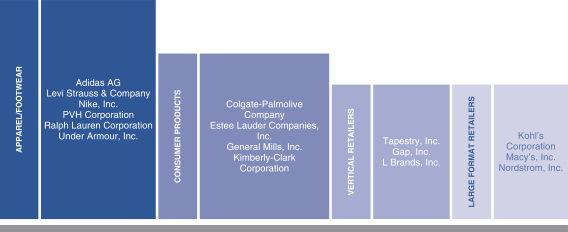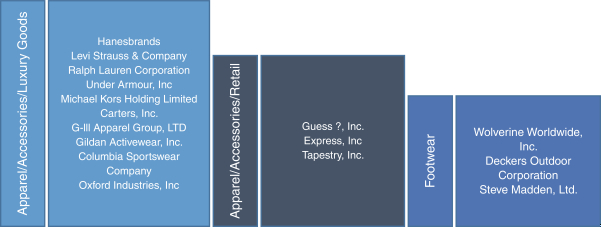Confidential Treatment Requested by Kontoor Brands, Inc.
Pursuant to 17 C.F.R. Section 200.83
include, but are not limited to, information technology, human resources, accounting shared services, supply chain, insurance, and the service cost component of net periodic pension costs. The Company was directly charged $106.1 million in 2018, $133.1 million in 2017 and $119.7 million in 2016 for these costs that were included in cost of goods sold and selling, general and administrative expenses in the combined statements of income.
In addition, for purposes of preparing the combined financial statements on a “carve-out” basis, a portion of VF’s total corporate expenses were allocated to us. These expense allocations include the cost of corporate functions and resources provided by VF including, but not limited to, executive management, finance, accounting, legal, human resources, the related benefit costs associated with such functions, such as stock-based compensation, and the cost of VF’s Greensboro, NC corporate headquarters. The Company was allocated $29.0 million in 2018, $32.9 million in 2017 and $28.7 million in 2016 for such corporate expenses, which were included within selling, general and administrative expenses in the combined statements of income.
The Company was also allocated a benefit of $5.1 million in 2018, benefit of $0.2 million in 2017 and expense of $15.4 million in 2016 for the non-service components of net periodic pension costs, which were included in selling, general and administrative expenses in the combined statements of income. In addition, the Company was allocated $3.5 million and $1.2 million for the Company’s portion of curtailment and pension settlement charges, respectively, in 2018, and $21.5 million for the Company’s portion of a pension settlement charge in 2016 recorded by VF. The curtailment and settlement charges were included in selling, general and administrative expenses.
Costs were allocated to us based on direct usage when identifiable or, when not directly identifiable, on the basis of proportional net revenues, cost of goods sold or square footage, as applicable. Management considers the basis on which the expenses have been allocated to reasonably reflect the utilization of services provided to, or the benefit received by, us during the periods presented. However, the allocations may not reflect the expenses we would have incurred if we had been a standalone company for the periods presented. Actual costs that may have been incurred if we had been a standalone company would depend on a number of factors, including the organizational structure, whether functions were outsourced or performed by employees, and strategic decisions made in areas such as information technology and infrastructure. Going forward, we may perform these functions using our own resources or outsourced services. For a period following the planned separation, however, some of these functions will continue to be provided by VF under a transition services agreement. Additionally, we may provide some services to VF under a transition services agreement. We also may enter into certain commercial arrangements with VF in connection with the Separation.
Subsequent to the completion of the Separation, we expect to incur expenditures to establish certain standalone functions and information technology systems, and other one-time costs. Recurring standalone costs include accounting, financial reporting, tax, regulatory compliance, corporate governance, treasury, legal, internal audit and investor relations functions, as well as the annual expenses associated with running an independent, publicly traded company including listing fees, board of director fees and external audit costs. We expect recurring standalone costs to be higher than historical allocations, which may have an impact on profitability and operating cash flows. See “Unaudited Pro Forma Combined Financial Statements” for more information.
The Company operates and reports using a 52/53 week fiscal year ending on the Saturday closest to December 31 of each year. All references to “2018”, “2017” and “2016” relate to the 52-week fiscal years ended December 29, 2018, December 30, 2017 and December 31, 2016, respectively. Certain foreign subsidiaries report using a December 31 year-end due to local statutory requirements.
All percentages shown in the tables below and the discussion that follows have been calculated using unrounded numbers.


